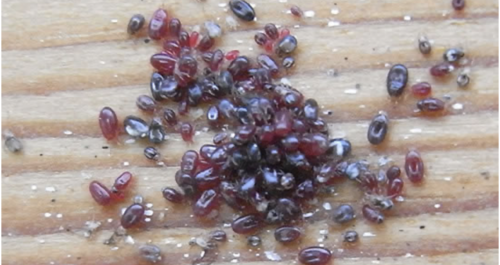Red Mite Problem Resolved

"Red mite do not live on the bird but lurk in the house and only go onto the bird when the warmth of the roosting hens lure them down."
Pammy Riggs
On their farm, Pammy and her husband Ritchie raise chickens commercially. Prioritising health and welfare by keeping less than 150 birds per house, they reduce stress levels and the need to use conventional medicines or chemicals.
Creativity in the Hen House
True stories
Fact: Off the shelf Red Mite Powder containing a hefty and effective insecticide was available and used by chicken keepers. One guy stippled his hen house up, down, in and out, covered it in roofing felt and had no red mite for 32 years. Powerful stuff!
Fact: Not long ago in the Netherlands, a cleaning company hired to deep-clean industrial sized hen units, between batches (no hens present) assumed it was safe to use non-food grade chemicals. Later when the hens were put to work, eggs were recalled from retail outlets and another huge number dumped! The cleaning chemicals had leached into the food chain via hen and egg. Again powerful stuff used in the ‘fight’ against Red Mite.
It need not be like this!
But it can be like this……..
Using cunning not chemicals!
I am sharing with you, a system devised on our farm that has thwarted any Red Mite infestation, and is, as the best inventions always are, very simple, easy for a ‘handy’ chicken keeper to implement and, so far, on our farm, 100% effective, chemical-free and I would even add that the hens themselves enjoy the improvements to the houses made with their well-being in mind.
This is certainly not just a small scale fix, it’s suitable on a commercial scale too. As long as each perch is well fixed (and ours held 100 laying hens at a time), it can be multiplied up indefinitely.
Familiarise yourself with the habits of the Red Mite. They lurk in crevices in the fabric of the hen house. Attracted by the body warmth of the sleeping hens, they swarm out for their nightly vampiric blood sucking activities, weakening otherwise healthy stock to the point of anaemia and sometimes death. Under perfect conditions Red Mite multiply exponentially. These are tiny eight-legged crawling mites, not jumpers like the common flea. Can we use this knowledge to our advantage by making access to our slumbering hens an impossibility? A tiny gap between daytime refuge and night time feeding is just the answer.

How?
On our holding we have achieved this very successfully by suspending the perches from the roof structure. If you want to be part of the next revolution in perch design, with a healthier, chemical-free approach to bird keeping as a result, think it through carefully to begin with, get out the tools and redesign your hen house.
Build everything with the aim of creating a gap between walls and perches; just a centimetre or two is enough to be effective. Make sure the perches are in a grid formation, suspend with wires, chain or strong twine. Allowing the perches a little leeway to swing seems to be an added bonus for the hens, perhaps it rekindles the feelings their ancestors had whilst swaying around in the jungle canopy!
Perch materials must start out 100% clean, (I would add that Red Mite harbour in crusty deposits on bird’s feathers too, so check out the birds too), then the only access to the birds is via the suspension ropes. For a belt and braces approach smear the suspension cables with some thick grease, near to the point of contact with the house. Vaseline, udder grease or even goose fat will do the trick.
Now the birds are safe from Red Mite, no chemicals have been used, and provided your hen house is beefed-up enough to take the weight of hens and perches, the problem is solved.
Get creative, put your chickens out of harm’s way with your own version of suspended perches and show us your design.
Email to: secretary@wholehealthag.org
Notes for perch adaptation
Average chicken weighs 3.5-4 kg.
Leave min. 18cm. perch space per bird.
Use 100% Red Mite free materials.
Use a grid formation with minimum 3 attachment points for stability.
Check ability of structure for strength before adaptation.
Suspend perch at suitable height from the ground, make it adjustable.

About the author: I’m Pammy, a farmer of many years who teachers courses, and writes about farming, animals, and much more!
